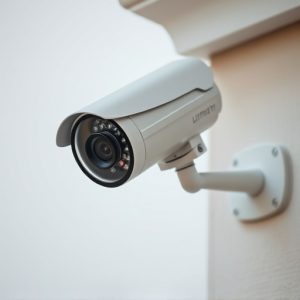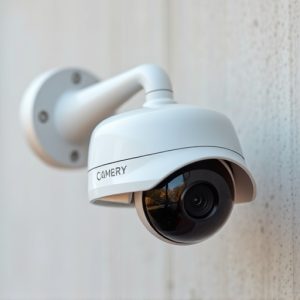Optimize Surveillance: Expert Tips for Dummy Camera Placement at Ideal Heights
Optimizing dummy security camera placement involves positioning them at 6-8 feet (2 meters) above gr…….
Optimizing dummy security camera placement involves positioning them at 6-8 feet (2 meters) above ground for clear views and deterrent effect, adhering to industry standards. Strategically place them near entrances, exits, and common areas for enhanced surveillance without excessive cost. The optimal height range is 5–10 feet (1.5–3 meters), adjusted based on environment: higher in urban areas with obstructions, lower in open fields for broader coverage. Avoiding eye level placement helps maintain discreteness while ensuring clear visuals and comprehensive coverage. Integrating dummy cameras with real ones at strategic locations, including blind spots, creates a powerful security network.
In the realm of home and business security, dummy surveillance cameras play a crucial role in deterring potential intruders. Understanding optimal placement starts with Dummy Security Camera Height Guidelines. This article navigates the art of strategically positioning these devices, focusing on key factors like height, visual coverage, and integration with existing security systems. By following these dummy camera placement tips, folks can enhance their surveillance tapestry, ensuring maximum protection without the hustle and bustle of complex installations.
- Understanding Dummy Camera Placement for Optimal Security
- Choosing the Right Height: A Key Factor in Surveillance Effectiveness
- Visual Considerations: Maximizing Coverage and Minimizing Obstruction
- Integrating Dummy Cameras with Existing Security Systems
Understanding Dummy Camera Placement for Optimal Security
Understanding Dummy Camera Placement for Optimal Security
When placing dummy security cameras, it’s crucial to consider their strategic positioning for maximum effectiveness. One of the key factors is height—dummy cameras should generally be placed at eye level or slightly elevated. This mimics real camera coverage and discourages potential intruders from lowering their heads or blocking the lens. According to industry guidelines, a dummy camera positioned at 6-8 feet (around 2 meters) above the ground offers a convincing visual deterrent without requiring excessive height clearance in most residential or commercial settings.
Additionally, placing dummy cameras in obvious locations, such as near entrances, exits, and common areas, sends a clear message that your property is under surveillance. Intermixing live and dummy cameras can also enhance overall security perception. Remember, the goal is to create an environment where potential threats are deterred by the visible presence of surveillance, making dummy camera placement a strategic and cost-effective security measure.
Choosing the Right Height: A Key Factor in Surveillance Effectiveness
Choosing the right height for your dummy security camera is a crucial factor in maximizing its effectiveness. According to industry guidelines, positioning cameras at a height of 5–10 feet (approximately 1.5–3 meters) above ground level offers an optimal field of view. This range ensures that the camera captures clear and detailed footage while also maintaining a discreet appearance, reducing the risk of potential vandals or thieves targeting it.
When selecting the appropriate height, consider the environment where the camera will be placed. For instance, in urban areas with buildings and trees, a higher placement might be necessary to avoid obstructions. Conversely, in open fields or rural settings, a lower angle could capture a broader area. Following these dummy security camera height guidelines will enhance the overall surveillance capabilities of your system.
Visual Considerations: Maximizing Coverage and Minimizing Obstruction
When determining dummy surveillance camera placement, visual considerations are paramount. The goal is to maximize coverage while minimizing obstruction—a balance that ensures clear and unobstructed views for optimal security. In terms of dummy security camera height guidelines, positioning them at eye level or slightly elevated is ideal. This standard height offers a comprehensive view without capturing unnecessary details that could obscure important areas. For instance, placing dummy cameras at door entrances, windows, and intersections provides thorough coverage without obstructing pedestrian or vehicular traffic flow.
Additionally, consider the surrounding environment. Natural features like trees or buildings can serve as distractions, so strategically position your dummy cameras to avoid these obstructions. Ensure that the camera’s field of view captures key areas without being unduly affected by environmental factors. This careful placement maximizes the visual coverage, enhancing security and deterring potential threats.
Integrating Dummy Cameras with Existing Security Systems
When integrating dummy surveillance cameras with existing security systems, it’s crucial to consider their placement for optimal effectiveness. One essential guideline to remember is the Dummy Security Camera Height Guidelines. Generally, placing them at eye level or slightly elevated ensures a realistic and effective deterrent. This positioning mimics genuine camera coverage, making would-be intruders think they’re being watched, thereby reducing potential crime.
For best results, align dummy cameras with real ones in terms of placement and field of view whenever possible. Strategically arrange them in areas where natural sightlines create blind spots for actual security cameras. This blend of genuine and dummy cameras creates a more comprehensive surveillance network, enhancing the overall security posture without breaking the bank.
When strategically placing dummy security cameras, understanding the importance of height, visual coverage, and integration with existing systems is key. Following the dummy security camera height guidelines ensures optimal visibility without obstructing crucial areas. By maximizing coverage while minimizing obstructions, you can create a comprehensive surveillance network that significantly enhances overall security. Integrating these cameras seamlessly into your existing system allows for a unified and effective security strategy, providing peace of mind in any environment.


